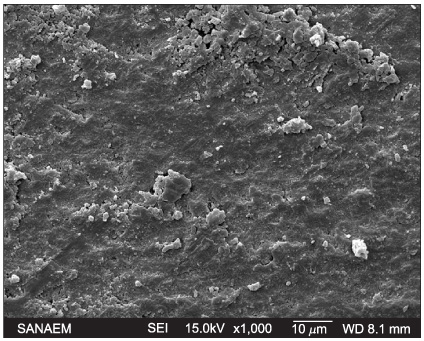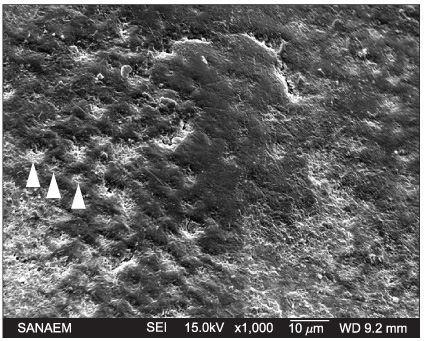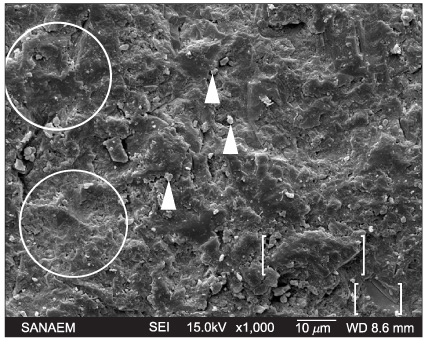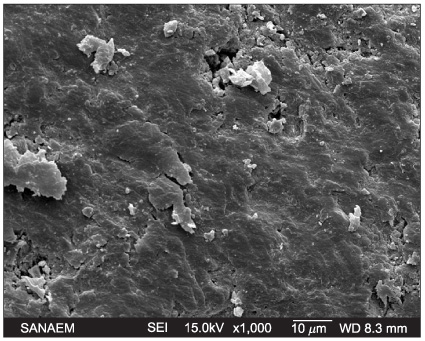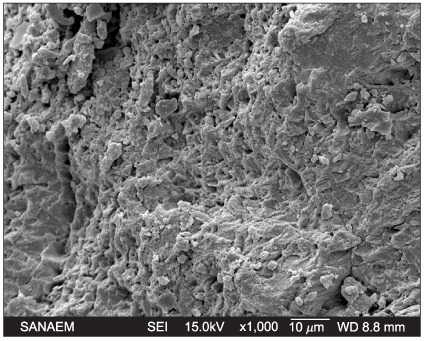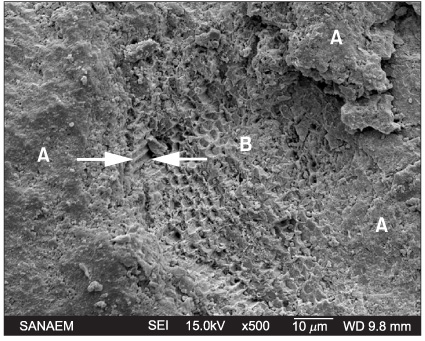Korean J Orthod.
2012 Feb;42(1):32-38.
Evaluation of different enamel conditioning techniques for orthodontic bonding
- Affiliations
-
- 1Department of Orthodontics, Dental Faculty, Gazi University, Ankara, Turkey. cturkoz@hotmail.com
Abstract
OBJECTIVE
The aim of this study was to compare the effects of different enamel conditioning techniques for bracket bonding.
METHODS
Ninety-one human premolars were randomly divided in six groups of 15 specimens each. The enamel surfaces of the teeth were etched with 35% orthophosphoric acid in Group 1, with a self-etching primer in Group 2, sandblasted in Group 3, sandblasted and etched with 35% orthophosphoric acid in Group 4, conditioned by Er:YAG laser in Group 5 and conditioned by Er:YAG laser and etched with 35% phosphoric acid gel respectively in Group 6. After enamel conditioning procedures, brackets were bonded and shear bonding test was performed. After debonding, adhesive remnant index scores were calculated for all groups. One tooth from each group were inspected by scanning electron microscope for evaluating the enamel surface characteristics.
RESULTS
The laser and acid etched group showed the highest mean shear bond strength (SBS) value (13.61 +/- 1.14 MPa) while sandblasted group yielded the lowest value (3.12 +/- 0.61 MPa).
CONCLUSIONS
Although the SBS values were higher, the teeth in laser conditioned groups were highly damaged. Therefore, acid etching and self-etching techniques were found to be safer for orthodontic bracket bonding. Sandblasting method was found to generate inadequate bonding strength.
MeSH Terms
Figure
Reference
-
1. Urabe H, Rossouw PE, Titley KC, Yamin C. Combinations of etchants, composite resins, and bracket systems: an important choice in orthodontic bonding procedures. Angle Orthod. 1999. 69:267–275.2. Zachrisson BU, Büyükyilmaz T. Recent advances in bonding to gold, amalgam, and porcelain. J Clin Orthod. 1993. 27:661–675.3. Faltermeier A, Behr M. Effect of bracket base conditioning. Am J Orthod Dentofacial Orthop. 2009. 135:12.e1–12.e5.
Article4. Chung K, Hsu B, Berry T, Hsieh T. Effect of sandblasting on the bond strength of the bondable molar tube bracket. J Oral Rehabil. 2001. 28:418–424.
Article5. Berk N, Basaran G, Özer T. Comparison of sandblasting, laser irradiation, and conventional acid etching for orthodontic bonding of molar tubes. Eur J Orthod. 2008. 30:183–189.
Article6. Canay S, Kocadereli I, Akça E. The effect of enamel air abrasion on the retention of bonded metallic orthodontic brackets. Am J Orthod Dentofacial Orthop. 2000. 117:15–19.
Article7. von Fraunhofer JA, Allen DJ, Orbell GM. Laser etching of enamel for direct bonding. Angle Orthod. 1993. 63:73–76.8. Klein AL, Rodrigues LK, Eduardo CP, Nobre dos, Cury JA. Caries inhibition around composite restorations by pulsed carbon dioxide laser application. Eur J Oral Sci. 2005. 113:239–244.
Article9. Üsümez S, Orhan M, Üsümez A. Laser etching of enamel for direct bonding with an Er,Cr:YSGG hydrokinetic laser system. Am J Orthod Dentofacial Orthop. 2002. 122:649–656.
Article10. Basaran G, Ozer T, Berk N, Hamamci O. Etching enamel for orthodontics with an erbium, chromium: yttrium-scandium-gallium-garnet laser system. Angle Orthod. 2007. 77:117–123.11. Basaran G, Hamamci N, Akkurt A. Shear bond strength of bonding to enamel with different laser irradiation distances. Lasers Med Sci. 2011. 26:149–156.
Article12. Hamamci N, Akkurt A, Basaran G. In vitro evaluation of microleakage under orthodontic brackets using two different laser etching, self etching and acid etching methods. Lasers Med Sci. 2010. 25:811–816.
Article13. Artun J, Bergland S. Clinical trials with crystal growth conditioning as an alternative to acid-etch enamel pretreatment. Am J Orthod. 1984. 85:333–340.
Article14. Lehman R, Davidson CL. Loss of surface enamel after acid etching procedures and its relation to fluoride content. Am J Orthod. 1981. 80:73–82.
Article15. Shey Z, Brandt S. Enamel loss due to acid treatment for bonding. J Clin Orthod. 1982. 16:338–340.16. Yamada R, Hayakawa T, Kasai K. Effect of using selfetching primer for bonding orthodontic brackets. Angle Orthod. 2002. 72:558–564.17. Reynolds IR. A review of direct orthodontic bonding. Br J Orthod. 1975. 2:171–178.
Article18. Olsen ME, Bishara SE, Damon P, Jakobsen JR. Comparison of shear bond strength and surface structure between conventional acid etching and air-abrasion of human enamel. Am J Orthod Dentofacial Orthop. 1997. 112:502–506.
Article19. Reisner KR, Levitt HL, Mante F. Enamel preparation for orthodontic bonding: a comparison between the use of a sandblaster and current techniques. Am J Orthod Dentofacial Orthop. 1997. 111:366–373.
Article20. Hossain M, Nakamura Y, Tamaki Y, Yamada Y, Murakami Y, Matsumoto K. Atomic analysis and knoop hardness measurement of the cavity floor prepared by Er,Cr:YSGG laser irradiation in vitro. J Oral Rehabil. 2003. 30:515–521.
Article21. Walsh LJ, Abood D, Brockhurst PJ. Bonding of resin composite to carbon dioxide laser-modified human enamel. Dent Mater. 1994. 10:162–166.
Article22. Visuri SR, Gilbert JL, Wright DD, Wigdor HA, Walsh JT Jr. Shear strength of composite bonded to Er:YAG laser-prepared dentin. J Dent Res. 1996. 75:599–605.
Article23. Ozer T, Başaran G, Berk N. Laser etching of enamel for orthodontic bonding. Am J Orthod Dentofacial Orthop. 2008. 134:193–197.
Article24. Roberts-Harry DP. Laser etching of teeth for orthodontic bracket placement: a preliminary clinical study. Lasers Surg Med. 1992. 12:467–470.
Article25. Corpas-Pastor L, Villalba Moreno J, de Dios Lopez-Gonzalez Garrido J, Pedraza Muriel V, Moore K, Elias A. Comparing the tensile strength of brackets adhered to laser-etched enamel vs. acid-etched enamel. J Am Dent Assoc. 1997. 128:732–737.
Article26. Scougall Vilchis RJ, Yamamoto S, Kitai N, Yamamoto K. Shear bond strength of orthodontic brackets bonded with different self-etching adhesives. Am J Orthod Dentofacial Orthop. 2009. 136:425–430.
Article27. Bishara SE, VonWald L, Laffoon JF, Warren JJ. Effect of a self-etch primer/adhesive on the shear bond strength of orthodontic brackets. Am J Orthod Dentofacial Orthop. 2001. 119:621–624.
Article28. Hosein I, Sherriff M, Ireland AJ. Enamel loss during bonding, debonding, and cleanup with use of a self-etching primer. Am J Orthod Dentofacial Orthop. 2004. 126:717–724.
Article
- Full Text Links
- Actions
-
Cited
- CITED
-
- Close
- Share
- Similar articles
-
- The effects of crystal growth on shear bond strength of orthodontic bracket adhesives to enamel surface
- The effects of a sealant resin on enamel demineralization in orthodontic bracket bonding
- Comparison of shear bond strength of different bonding systems on bleached enamel
- Orthodontic bonding to acid- or laser-etched prebleached enamel
- A Comparison of shear Bonding Strength with Polyacrylic acid and Phosphoric acid Enamel Surface Conditioning

